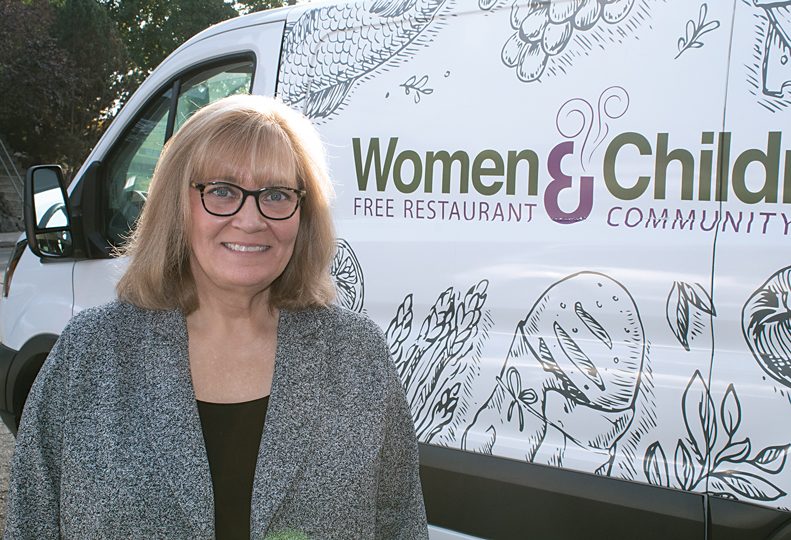
Home » Individual giving varies across INW nonprofits
Individual giving varies across INW nonprofits
Economic factors, lower event attendance among reasons for fewer donors

Lisa Diffley, executive director of Women & Children's Free Restaurant & Community Kitchen, says the nonprofit is on track to serve over 1.1 million meals this year.
| Dylan HarrisOctober 24, 2024
For most nonprofits, individual donations make up a small percentage of funding. Those funds, however, typically are unrestricted, meaning they can help fill the gaps not covered by larger funding sources, like grants, for example.
“One of the challenges we have in our work is that governmental grants are pretty restrictive with what they cover,” says Fawn Schott, president and CEO of Volunteers of America Eastern Washington, which has the mission to take a holistic approach to help those facing homelessness in the Inland Northwest. “To meet the true needs of individuals in their recovery, they typically need some less restrictive, more flexible funds to be able to assist them in meeting their needs.”
During the COVID-19 pandemic, individual giving rose significantly, according to Lisa Diffley, executive director of Spokane-based Women & Children’s Free Restaurant & Community Kitchen.
From 2019 to 2020, individual giving had gone up about 150% at Women’s & Children’s Free Restaurant. The sharp increase was driven by the growing need at the time, which Diffley says has continued to rise.
Now, however, nonprofits in the Inland Northwest are seeing varying levels of financial support at the individual level.
“If you look at 2020, which was kind of a landmark year, and then you look at 2023, the donations trended down about 18% to 20%.”
Individual donations are down so far this year at Women & Children’s Free Restaurant, but Diffley says that could change by year-end.
“A lot of folks do it at the end of the year,” she says. “They like to tie it to the holidays.”
YWCA Spokane has experienced a different trend in recent years, in part due to a change in philanthropic strategy since the pandemic.
Despite having the number of individual gifts drop 31% last year compared with 2019, total funding from individual donors has risen by 49% in the same period, says Dana Morris Lee, chief philanthropy officer at YWCA Spokane.
That increase in funding, albeit from a smaller pool of individual donors, is the result of a shift to a more relationship-based fundraising strategy, she says.
“We had three events a year, and now we only have two when we came out of COVID,” says Morris Lee. “We really put our focus more toward individual relationship building.”
Relationship-based fundraising involves spending more one-on-one time with donors and trying to understand what their passions are, Morris Lee explains.
“When you take the time to do that, you're matching up a community need with people who really have a deep passion and interest for the work that you're doing,” says Morris Lee. “And that turns into a larger gift.”
Volunteers of America Eastern Washington, on the other hand, has seen its individual donor funds decrease in the past couple years, and Schott says the organization isn't alone in that trend.
Volunteers of America Eastern Washington's funding from individual donations has decreased by about 30% since 2021, Schott says.
“I know from conversations with other colleagues, that definitely seems to be a trend that we’re all seeing,” she says.
The decrease in funding at Volunteers of America Eastern Washington is in part due to there being fewer individual donors, she says.
Schott attributes some of the steep decline in individual donations to the current state of the economy.
“When people feel like their basic needs are met in their household, they’re more willing to be able to share with our nonprofit community,” Schott says. “But when it’s tough to make their own ends meet, and hard to fill up their gas tank, fill up their fridge, and pay for day care, it makes it really challenging.”
Jeanette Hauck, CEO of YWCA Spokane, echoes a similar sentiment as to why individual donations may be down for some nonprofits.
“My overall impression is that anytime it's an election year, anytime there's high inflation, anytime there's any sort of insecurity, people are going to stop and think twice before they donate because of uncertainty,” Hauck says.
Another possible factor behind the decline in individual donors is the number of people who attend events.
“I think when COVID shifted everybody away from gathering and having events, that probably minimized the amount of exposure that nonprofits had in the community, because I know a lot of the acquisition of a lot of new donors came from those events,” says Morris Lee.
Schott says she has noticed the same trend.
“As nonprofits, we used to really rely on events, and people just are attending less events.”
Ultimately, less individual donor funding could have a dire impact on people in need in the Spokane community.
For Women & Children’s Free Restaurant, less unrestricted individual donor funds would mean less food that the organization can buy. At YWCA, it could mean less money to go toward legal representation that supports people with domestic violence protection orders. Less funding at Volunteers of America could mean an increase in individuals facing homelessness.
Diffley says that even if people aren’t able to give financially because of the current state of the economy or other factors, they can consider volunteering their time instead.
“It has a lot of value to a nonprofit,” she says.
Latest News Up Close
Related Articles
Related Products
Related Events


![Brad head shot[1] web](https://www.spokanejournal.com/ext/resources/2025/03/10/thumb/Brad-Head-Shot[1]_web.jpg?1741642753)

